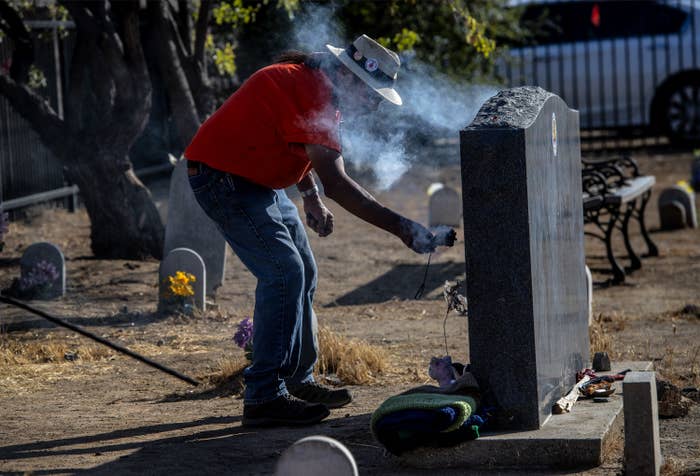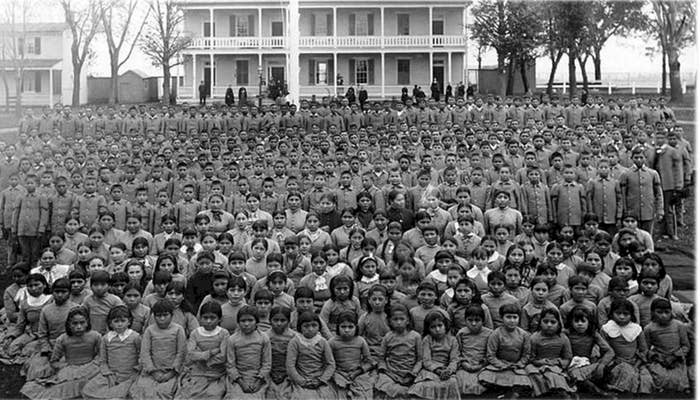
The remains of more than 500 children were discovered at burial sites as part of a wide-ranging investigation into the Indian boarding school system that systematically erased Indigenous culture across the US from the early 1800s to around 1970, according to a new report released on Wednesday.
Despite being a historic first assessment of the atrocities committed at the boarding schools, the Department of Interior report, which will be released in separate volumes, is incomplete, as it does not "include an exhaustive list of all burial sites," identify the children in the schools, or how they died. The pandemic and some government red tape also limited its scope, the authors wrote.
Furthermore, the number of children whose bodies were dumped in the mass graves is expected to be much higher, since, for nearly 150 years, the US forced tens of thousands of children into these government-sponsored schools, many of whom never came home, their families never being told what had happened. Nearly every Native American has a parent, grandparent, or another relative who survived the abusive system.
Still, the early results of the report released Wednesday are damning and confirm what survivors and their family members have long been describing: a systematic effort by the US government and Christian institutions to erase their existence and cultures by targeting and taking away their children.
“This ... reaffirms the stories we all grew up with, the truth of our people, and the often immense torture our elders and ancestors went through as children at the hands of the federal government and the religious institutions," said Deborah Parker, the CEO of the National Native American Boarding School Healing Coalition, which helped the government with its probe. "The impacts of boarding schools are still with us today."
Advocates have been cataloging atrocities on their own for decades and have long called for official federal recognition and documentation. Last year, Interior Secretary Deb Haaland, a citizen of the Pueblo of Laguna whose grandparents survived boarding schools, ordered a formal investigation to “uncover the truth about the loss of human life and the lasting consequences.”
The investigation explained that in 1803, President Thomas Jefferson told Congress in a confidential meeting that he wanted to create policies to separate Indian tribes from their land. The main strategy was forcing their children to be Christian Americans, and the government tapped and paid churches to help run the system. Children were "coerced, induced, or compelled" to enter the schools, many without their parents' consent.
From 1819 to 1969, the report found, the US operated 408 schools across 37 states (originally territories). Schools stretched as far as Alaska, which had at least 21, and Hawaii. Oklahoma had the largest number, with 76, followed by Arizona and New Mexico. The government often used money held in federal trust accounts for Indian tribes to pay for the costs of taking and culturally dismantling Native children.
These schools had the capacity to house up to 1,700 children, who were often severely mistreated. According to the report, students endured "rampant physical, sexual, and emotional abuse; disease; malnourishment; overcrowding; and lack of health care." As part of their "education," administrators also made them do hours of "industrial work," including cooking and cleaning, farming fields, and working on railroad systems.
Government officials at the time stated that it "was indispensably necessary that [the Indians] be placed in positions where they can be controlled, and finally compelled, by stern necessity, to resort to agricultural labor or starve,” according to the report.
Due to the dire conditions, scores of students died and their bodies were often dumped in mass graves. At 53 schools, investigators found marked and unmarked burial sites. Out of 408 institutions, 19 accounted for the deaths of more than 500 children, according to the report.
"As the investigation continues, the Department expects the number of recorded deaths to increase," the report states.

When students arrived, officials intentionally stripped them of their identities by giving them English names, cutting their hair, preventing them from using their native languages and cultural practices, and "organizing Indian and Native Hawaiian children into units to perform military drills," the report states.
The children were so regimented that there was "little opportunity to exercise any power of choice." At times, the US “military was frequently called in to reinforce the missionaries’ orders."
If they did not follow the rules, teachers and administrators often beat and tortured the children. Punishments included solitary confinement, flogging, starvation, whipping, slapping, and cuffing.
While the investigation is a huge step, there is still a lot more work to do, Haaland said Wednesday. Congress is funneling $7 million more to help members of the initiative continue to locate and sift through sites, as well as hundreds of thousands of government records for the report's second volume. Efforts to preserve tribal languages are also part of the initiative.
In response to calls for substantial mental and emotional health services due to the immense intergenerational trauma families and survivors have carried for decades, Haaland announced a "Road to Healing" program modeled closely after Canada's efforts to give voice to and document Native and Indigenous people's stories.
For a year, members of the initiative will travel across the US "to allow American Indian, Alaska Native, and Native Hawaiian survivors of the federal Indian boarding school system the opportunity to share their stories, help connect communities with trauma-informed support, and facilitate collection of a permanent oral history," the Interior Department said.
"It is my priority to not only give voice to the survivors and descendants of federal Indian boarding school policies, but also to address the lasting legacies of these policies so Indigenous peoples can continue to grow and heal," Haaland said.
